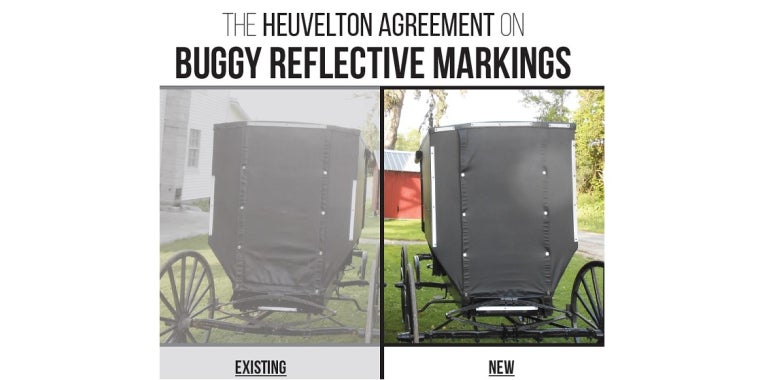
Historic Agreement to Improve Visibility of Horse-Drawn Buggies
Patty Ritchie
July 22, 2015

Nearly Doubles Reflective Markings on Buggies to Help Avoid Crashes
Senator Patty Ritchie, St. Lawrence County Sheriff Kevin Wells, County Legislators and leaders of local Amish communities today announced agreement on a plan that nearly doubles the reflective markings on horse-drawn buggies to make them more visible to motorists at night to help avoid crashes.
Under the agreement, owners of the buggies will use a total of 144 square inches of reflective tape—nearly twice the amount now required under state law—including first-ever reflective markings on the side of the buggies.
“Safety on our roadways is everyone’s business, and thanks to a genuine spirit of cooperation by Amish and county leaders, I’m pleased that we have been able to find a solution that improves the safety of both Amish and non-Amish who use our roadways, and makes travel on our North Country roads safer for everyone.”
“I applaud Sheriff Wells, County Legislators Larry Denesha and Joe Lightfoot, the New York State Police and the Amish bishops who came together to find a solution that not only improves the safety of our highways, but also continues to respect the traditions and beliefs of our Amish neighbors and friends,” said Senator Ritchie.
Among the changes accepted by the Amish representatives:
· * Nearly doubling the amount of reflective tape that buggy owners apply to increase visibility after dark. State law currently requires a total of 72 square inches of tape on the rear of buggies, plus an additional six inches on the front upright post. Under the agreement, buggies will use a total of 144 square inches of tape;
· * Increasing by 50 percent the amount of tape on the rear of the buggy. Most motor vehicle/buggy collisions occur from behind, and the addition of extra tape is consistent with safety efforts to increase markings on the rear of trucks that has resulted in a significant drop in collisions.
· * The increased rear markings will more completely trace the buggies’ outlines, making them more easily recognizable after dark, as well as improving visibility.
· * The addition of reflective tape to the right side of the buggy (when viewed from the rear), as well as the horse shaft in front of the buggy, making them more visible from crossroads and intersections.
· * Adding extra tape to the front of the buggy, so they can be more easily seen by opposing traffic.
· Additionally, Amish leaders will urge community members to upgrade the red lenses in the kerosene lanterns required on the left side of buggies, as well as using white paint on the inside of the lantern to make the light more visible.
More complete details, including pictures of buggies that comply with the new rules van be found by clicking HERE and HERE.
The changes are the first since local Amish leaders reached agreement in 1984 on marking standards that eventually were adopted in law.
“For the St. Lawrence County Sheriff’s Office, public safety is our top concern,” said St. Lawrence County Sheriff Kevin Wells. “But, making our county a safe place can’t be done by our team alone—it takes everyone’s efforts. By working together we’ve reached a solution that will make our local roads safer for all who utilize them, whether they’re traveling by motorized vehicle or by horse-drawn buggy.”
“As the Amish population has grown in recent years, so has the North Country’s need to adapt to the beliefs and customs of our new neighbors,” said St. Lawrence County Legislator Larry Denesha. “This agreement—which will help to make buggies more visible on the roadways—is a perfect example of how we can share the responsibility of keeping St. Lawrence County safe.”
“Anyone who has traveled our roads at night know that buggies can be very difficult to see—and that poses a danger not only for motorists, but also for the Amish,” said Joe Lightfoot, Chair of the St. Lawrence County Board of Legislators. “While we all still need to be cautious as we share the roads, I believe the compromise we’ve reached will go a long way towards making travel safer for everyone in our region.”
The agreement followed a summit of community leaders arranged by Senator Ritchie, and a series of tests using a variety of different reflective tapes to try to find one that would work best to improve visibility and safety. In the end, the leaders agreed that adding more reflective material tape was the best solution.
The agreement includes representatives of Amish church districts surrounding the “Heuvelton settlement,” the fastest-growing Amish community in the state. The bishops said they would work with other communities across the North Country to encourage them to adopt the changes in their own communities.
Because they exceed the requirements of state law, the changes are voluntary. But the bishops asked Sheriff Wells to work with members of the Amish community to assure compliance with the new rules.
“These changes will make a difference in improving the visibility of these buggies, and making our roads safer. But safety is everyone’s responsibility, and it’s important that we all remember to use caution and share the road with other users, whether in cars or trucks, motorcycles, wagons, buggies, bicycles and on foot,” Senator Ritchie said.
Over the past three years, Senator Ritchie has teamed with communities in Northern and Central New York to help raise awareness of the growing presence of Amish buggies on area highways to help boost safety. Those efforts have included:
· Partnering with area colleges to raise awareness among students—many of whom are new to the area—about the possibility of encountering buggies on the highway;
· Providing special funding for installation of 100 new roadside warning signs to alert motorists of the presence of buggies on county roads in communities with large Amish populations.
There have been at least a dozen accidents in recent years in the North Country involving motor vehicles and the horse-drawn buggies, causing thousands of dollars in property damage, the deaths of two horses and at least one human fatality.
Additional details on the changes can be found in the attached document.
Share this Article or Press Release
Newsroom
Go to NewsroomRitchie Announces Renee Palmer as 2022 "Woman of Distinction"
September 1, 2022

Senator Ritchie 2022 Woman of Distinction
August 26, 2022


